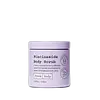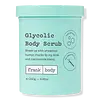What's inside
What's inside
 Key Ingredients
Key Ingredients

 Benefits
Benefits

 Concerns
Concerns

 Ingredients Side-by-side
Ingredients Side-by-side

Glycerin
HumectantSucrose
HumectantMagnesium Sulfate
Propanediol
SolventButyrospermum Parkii Butter
Skin ConditioningSodium Cocoyl Isethionate
CleansingCetearyl Alcohol
EmollientNiacinamide
SmoothingEuterpe Oleracea Fruit Extract
Lycium Barbarum Fruit Extract
AstringentVaccinium Myrtillus Fruit Extract
Skin ConditioningCamellia Sinensis Leaf Extract
AntimicrobialCoffea Arabica Seed Oil
MaskingAloe Barbadensis Leaf Juice Powder
Skin ConditioningWater
Skin ConditioningLauric Acid
CleansingParfum
MaskingPotassium Sorbate
PreservativeSodium Benzoate
MaskingCitric Acid
BufferingHexyl Cinnamal
PerfumingLimonene
PerfumingLinalool
PerfumingCI 60730
Cosmetic ColorantCI 17200
Cosmetic ColorantGlycerin, Sucrose, Magnesium Sulfate, Propanediol, Butyrospermum Parkii Butter, Sodium Cocoyl Isethionate, Cetearyl Alcohol, Niacinamide, Euterpe Oleracea Fruit Extract, Lycium Barbarum Fruit Extract, Vaccinium Myrtillus Fruit Extract, Camellia Sinensis Leaf Extract, Coffea Arabica Seed Oil, Aloe Barbadensis Leaf Juice Powder, Water, Lauric Acid, Parfum, Potassium Sorbate, Sodium Benzoate, Citric Acid, Hexyl Cinnamal, Limonene, Linalool, CI 60730, CI 17200
Water
Skin ConditioningPumice
AbrasiveGlycolic Acid
BufferingPalmitic Acid
EmollientCetearyl Alcohol
EmollientStearic Acid
CleansingSodium Hydroxide
BufferingLactic Acid
BufferingGlycerin
HumectantCetearyl Olivate
Sorbitan Olivate
EmulsifyingXanthan Gum
EmulsifyingCocos Nucifera Oil
MaskingMelaleuca Alternifolia Leaf Oil
AntioxidantTocopherol
AntioxidantSodium Hyaluronate
HumectantHamamelis Virginiana Leaf Extract
Skin ConditioningNiacinamide
SmoothingAleurites Moluccanus Seed Oil
Skin ConditioningEucalyptus Globulus Leaf Oil
PerfumingMacadamia Ternifolia Seed Oil
EmollientLeuconostoc/Radish Root Ferment Filtrate
AntimicrobialAloe Barbadensis Leaf Juice Powder
Skin ConditioningAlthaea Officinalis Root Extract
Skin ConditioningLycium Barbarum Fruit Extract
AstringentCharcoal Powder
AbrasiveVitis Vinifera Seed Oil
EmollientTheobroma Cacao Seed Extract
AntioxidantQuartz
AbrasiveLauric Acid
CleansingMyristic Acid
CleansingArachidic Acid
CleansingBenzyl Alcohol
PerfumingPhenoxyethanol
PreservativeAlcohol
AntimicrobialParfum
MaskingLimonene
PerfumingWater, Pumice, Glycolic Acid, Palmitic Acid, Cetearyl Alcohol, Stearic Acid, Sodium Hydroxide, Lactic Acid, Glycerin, Cetearyl Olivate, Sorbitan Olivate, Xanthan Gum, Cocos Nucifera Oil, Melaleuca Alternifolia Leaf Oil, Tocopherol, Sodium Hyaluronate, Hamamelis Virginiana Leaf Extract, Niacinamide, Aleurites Moluccanus Seed Oil, Eucalyptus Globulus Leaf Oil, Macadamia Ternifolia Seed Oil, Leuconostoc/Radish Root Ferment Filtrate, Aloe Barbadensis Leaf Juice Powder, Althaea Officinalis Root Extract, Lycium Barbarum Fruit Extract, Charcoal Powder, Vitis Vinifera Seed Oil, Theobroma Cacao Seed Extract, Quartz, Lauric Acid, Myristic Acid, Arachidic Acid, Benzyl Alcohol, Phenoxyethanol, Alcohol, Parfum, Limonene
 Reviews
Reviews

Ingredients Explained
These ingredients are found in both products.
Ingredients higher up in an ingredient list are typically present in a larger amount.
Aloe Barbadensis Leaf Juice Powder comes from the aloe plant.
You may know Aloe to be a good sunburn reliever and inflammation reducer. This is because it contains many components that are known to help reduce irritation and itchiness.
Aloe leaves are also great moisturizers. They are naturally rich in polysaccharides, a carbohydrate made of sugars. Polysaccharides are able to mimic the carbs found in the top layer of your skin. This can help keep your skin hydrated.
Aloe contains the antioxidants Vitamins A, C, and E. These vitamins neutralize free radicals. Free-radicals are molecules that may damage your skin cells, such as pollution.
Aloe does not protect against UV rays, despite it soothing sunburns.
Learn more about Aloe Barbadensis Leaf Juice PowderCetearyl alcohol is a mixture of two fatty alcohols: cetyl alcohol and stearyl alcohol. It is mainly used as an emulsifier. Emulsifiers help prevent the separation of oils and products. Due to its composition, it can also be used to thicken a product or help create foam.
Cetearyl alcohol is an emollient. Emollients help soothe and hydrate the skin by trapping moisture.
Studies show Cetearyl alcohol is non-toxic and non-irritating. The FDA allows products labeled "alcohol-free" to have fatty alcohols.
This ingredient is usually derived from plant oils such as palm, vegetable, or coconut oils. There is debate on whether this ingredient will cause acne.
Due to the fatty acid base, this ingredient may not be Malassezia folliculitis safe.
Learn more about Cetearyl AlcoholGlycerin is already naturally found in your skin. It helps moisturize and protect your skin.
A study from 2016 found glycerin to be more effective as a humectant than AHAs and hyaluronic acid.
As a humectant, it helps the skin stay hydrated by pulling moisture to your skin. The low molecular weight of glycerin allows it to pull moisture into the deeper layers of your skin.
Hydrated skin improves your skin barrier; Your skin barrier helps protect against irritants and bacteria.
Glycerin has also been found to have antimicrobial and antiviral properties. Due to these properties, glycerin is often used in wound and burn treatments.
In cosmetics, glycerin is usually derived from plants such as soybean or palm. However, it can also be sourced from animals, such as tallow or animal fat.
This ingredient is organic, colorless, odorless, and non-toxic.
Glycerin is the name for this ingredient in American English. British English uses Glycerol/Glycerine.
Learn more about GlycerinLauric Acid is a fatty acid or lipid. About half of fatty acids in coconut oil is lauric acid.
This ingredient helps hydrate and sooth skin. As a humectant, it helps trap moisture. It also aids in cleaning and enhancing the texture of products.
Lauric acid may not be Malassezia folliculitis, or fungal acne, safe.
Learn more about Lauric AcidLimonene is a fragrance that adds scent and taste to a formulation.
It's found in the peel oil of citrus fruits and other plants such as lavender and eucalyptus. The scent of limonene is generally described as "sweet citrus".
Limonene acts as an antioxidant, meaning it helps neutralize free radicals.
When exposed to air, oxidized limonene may sensitize the skin. Because of this, limonene is often avoided by people with sensitive skin.
The term 'fragrance' is not regulated in many countries. In many cases, it is up to the brand to define this term. For instance, many brands choose to label themselves as "fragrance-free" because they are not using synthetic fragrances. However, their products may still contain ingredients such as essential oils that are considered a fragrance.
Learn more about LimoneneLycium Barbarum Fruit Extract comes from the Goji Berry. Goji berries are native to China and can be found across Eurasia.
Goji berries contain polysaccharides, carotenoids and flavonoids. Antioxidants help your body fight off free-radical molecules. These molecules are unstable and may damage your skin. By making free-radicals more stable, antioxidants can help with anti-aging.
Polysaccharides help hydrate the top layer of skin due to its ability to mimic natural carbohydrates.
Learn more about Lycium Barbarum Fruit ExtractNiacinamide is a multitasking form of vitamin B3 that strengthens the skin barrier, reduces pores and dark spots, regulates oil, and improves signs of aging.
And the best part? It's gentle and well-tolerated by most skin types, including sensitive and reactive skin.
You might have heard of "niacin flush", or the reddening of skin that causes itchiness. Niacinamide has not been found to cause this.
In very rare cases, some individuals may not be able to tolerate niacinamide at all or experience an allergic reaction to it.
If you are experiencing flaking, irritation, and dryness with this ingredient, be sure to double check all your products as this ingredient can be found in all categories of skincare.
When incorporating niacinamide into your routine, look out for concentration amounts. Typically, 5% niacinamide provides benefits such as fading dark spots. However, if you have sensitive skin, it is better to begin with a smaller concentration.
When you apply niacinamide to your skin, your body converts it into nicotinamide adenine dinucleotide (NAD). NAD is an essential coenzyme that is already found in your cells as "fuel" and powers countless biological processes.
In your skin, NAD helps repair cell damage, produce new healthy cells, support collagen production, strengthen the skin barrier, and fight environmental stressors (like UV and pollution).
Our natural NAD levels start to decline with age, leading to slower skin repair, visible aging, and a weaker skin barrier. By providing your skin niacinamide, you're recharging your skin's NAD levels. This leads to stronger, healthier, and younger looking skin.
Another name for vitamin B3 is nicotinamide. This vitamin is water-soluble and our bodies don't store it. We obtain Vitamin B3 from either food or skincare. Meat, fish, wheat, yeast, and leafy greens contain vitamin B3.
The type of niacinamide used in skincare is synthetically created.
Learn more about NiacinamideParfum is a catch-all term for an ingredient or more that is used to give a scent to products.
Also called "fragrance", this ingredient can be a blend of hundreds of chemicals or plant oils. This means every product with "fragrance" or "parfum" in the ingredients list is a different mixture.
For instance, Habanolide is a proprietary trade name for a specific aroma chemical. When used as a fragrance ingredient in cosmetics, most aroma chemicals fall under the broad labeling category of “FRAGRANCE” or “PARFUM” according to EU and US regulations.
The term 'parfum' or 'fragrance' is not regulated in many countries. In many cases, it is up to the brand to define this term.
For instance, many brands choose to label themselves as "fragrance-free" because they are not using synthetic fragrances. However, their products may still contain ingredients such as essential oils that are considered a fragrance by INCI standards.
One example is Calendula flower extract. Calendula is an essential oil that still imparts a scent or 'fragrance'.
Depending on the blend, the ingredients in the mixture can cause allergies and sensitivities on the skin. Some ingredients that are known EU allergens include linalool and citronellol.
Parfum can also be used to mask or cover an unpleasant scent.
The bottom line is: not all fragrances/parfum/ingredients are created equally. If you are worried about fragrances, we recommend taking a closer look at an ingredient. And of course, we always recommend speaking with a professional.
Learn more about ParfumWater. It's the most common cosmetic ingredient of all. You'll usually see it at the top of ingredient lists, meaning that it makes up the largest part of the product.
So why is it so popular? Water most often acts as a solvent - this means that it helps dissolve other ingredients into the formulation.
You'll also recognize water as that liquid we all need to stay alive. If you see this, drink a glass of water. Stay hydrated!
Learn more about Water